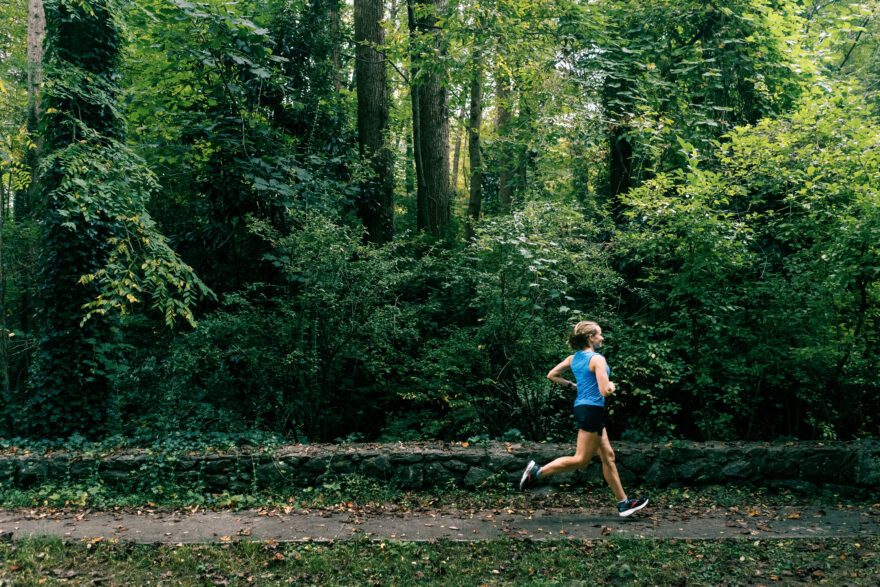


Wondering what muscles you can expect to develop and what will likely be sore as you start running and ramp up your miles? Read this post to learn what muscles running works, why they’re important and how to strengthen them.
Strong legs are 100% a key to being a strong runner. But that’s a little too general. We need to know which muscles do what, how they work together, how we’re supposed to strengthen them and why. We also need to understand how the rest of our body is involved in running. Think about it like riding a bike. Sure, you use your feet and legs to pedal, but you also use your hands and core to stabilize. And without the core and your arms, you’d fall off the bike!
The rest of your body plays an essential role in your ability to train. And that’s what we’re talking about today in this post. We’re going to dive into the details of each muscle and how it relates to running. And what better way to do that than with a professional runner? My friend Joanna is going to share the ins and outs of your muscles and how they work to make you a faster runner.
Take it away, Joanna!
Hi everyone! It’s Joanna here! I’m so excited to be a contributor to A Foodie Stays Fit! If you’ve missed my previous posts, you can read more from me on the pros & cons of a GPS running watch and distance running tips for beginners. A quick recap of me: I’m a professional runner for On Zap Endurance and at the time that I wrote this, I was knee-deep in training for the Olympic Marathon trials that were coming up in Atlanta in February 2020. That means I had LOTS of tired muscles (and a tired mind, at times too!). Today I’m sharing all about the muscles that keep us running, what they are, why they matter, and how to keep them strong so you can keep running strong and long!
Running is fantastic for cardiovascular health, stress relief, building friendships and building muscle in the legs. You may think that all runners are super skinny without a lot of muscle, but some of the strongest people I know are runners. Depending on the type of runner you are (track vs. middle distance vs. endurance vs. ultra ) and the specifics of your training and your genetics, you may develop muscles differently. But, having strong, resilient muscles are key for ALL types of runners. By strengthening a few key muscle groups, you’ll improve form, endurance, and power while also reducing running injuries. Let’s dive in!
Let’s face it: runners have great legs.
It won’t come as a surprise to hear that running, especially long-distance running, works a lot of leg muscles. But what makes you, a runner, move? Which muscles are the “running muscles”? Let’s take a closer look at the five main muscle groups responsible for keeping you in motion, and why it’s important to strengthen them. I shared examples of exercises but there are also lots of free workout apps to guide you. I know Teri really likes the Strength for Runners classes on the Peloton app!
The human butt is an amazing thing. It’s one of the essential features that make our species bipedal; since most other animals lack the strong gluteal muscles to stabilize their hips and spine, they cannot maintain balance on two legs.
That stabilization is crucial for running. When you run, the three major muscles of the glutes – the gluteus maximus, medius, and minimus – act as a combination shock absorber and gyroscope, reducing the force of impact while also keeping your hips and knees underneath you.
Weak glutes can result in knee pain and bad posture, neither of which improves your run, regardless of distance. If you want to keep your gluteals operating at maximum capacity, clamshell and bridge exercises are a great place to start.

Like the glutes, your hip flexors play a key role in running stabilization. Technically, “hip flexors” refer to a group of five different leg muscles, but when runners talk about them we usually just mean two: the iliacus and the psoas (that’s “so-az”) major.
Your hip flexor muscles are incredibly strong – a recent study found that in order to perform their job, these muscles must generate force equivalent to over 10 times the weight of your leg. Unfortunately, that heavy lifting means that your hip flexors are prone to tightening up.
Generally speaking, it’s more important to keep your hip flexors, well, flexible, rather than super toned (they’ll do that part on their own).
For happy hips, try some basic hip extension exercises, such as pendulums or the butterfly stretch. You can even make hip stretching part of your ab routine by incorporating bicycle sit-ups.
When you begin a stride, the quadriceps are the first muscles to engage. They reside at the front of your thigh, and extend from the hips down to the kneecap. Your quads consist of four muscles (the vastus medialis, intermedius, lateralus, and rectus femoris, in case you were curious) which work in tandem to move your leg up and forward. Basically, without quads, you wouldn’t be able to extend your knee.
As you might imagine, the quads play a particularly important role in running up and down inclines. If you are training for a hilly race and need to keep your quads strong, I would recommend incorporating bodyweight squats and lunges into your strength training routine.
While powerful quads are essential to running fast, it’s important to keep them in balance. It’s pretty common for distance runners to develop much stronger quadriceps muscles compared to their hamstrings, which can lead to lower back pain and hip tightness. Lunges help keep your quads strong.
That brings us to…
As your body moves forward through a step, your hamstrings take over for your quadriceps. Composed of the semitendinosus, the semimembranosus, and the two biceps femoris, the hamstrings are essentially anti-quads. They sit directly behind them, at the backs of the thighs, and are responsible for bending your knee so that your feet move toward your butt.
Tight or strained hamstrings have been the number one bane of my running career, plaguing me since college. The best exercise I’ve found to strengthen my hammies without aggravating them is, believe it or not, yoga. I try to include 30 minutes of yoga poses per week in training (usually on a recovery day). Again, the Peloton app has great yoga classes! But if namaste isn’t your jam, deadlifts and lying leg curls also work wonders.
Finally, we come to the calves. You have two calf muscles: the gastrocnemius and soleus. The gastrocnemius is the superficial calf, and the soleus is the deep calf. Located at the back of your lower legs, just beneath the knee, these muscles are responsible for flexing your ankles and pushing your feet off the ground.
Weak calves lead to a whole host of problems, from shin splints, to Achilles tendonitis, to plantar fasciitis. All of these are incredibly common injuries for athletes who have just started running and haven’t had time to build calf strength. To help prevent calf weakness — and help prevent injury!! — you need to strength train your calves. Throw in a couple sets of calf raises or ankle hops once or twice a week. Or, as a cheat code, try walking on tiptoe for 30 seconds at a time; this will go a long way towards strong calves, and you can do it anywhere.
So wait a second, you might be thinking, if running engages all these leg muscles, why am I spending so much time doing crunches in the gym? I’m glad you asked.
Running is truly a full-body endeavor – in order to run your best, you need strong core muscles and even upper body muscles in addition to killer legs.
When your run coach says “core”, they’re referring to basically all of the muscle in your torso – the abs, obliques, diaphragm, and spine stabilizers. While the motion of running does not engage these muscles directly, they still play a vital role: namely, helping you to breathe. In addition to keeping your lungs pumping, a strong core will help stabilize your hips and hold your center of gravity steady, which is so important for short and long runs.
As for your arms, shoulders, and upper back, these muscles help to smooth out your stride by providing counterbalance as you swing your arms. It might not sound like a lot, but this is vital to stride efficiency (don’t believe me? Try running with your arms behind your back). Some light bodyweight exercises, like push-ups or pull-ups, are all you need to keep your runner’s arms in shape.
Did you know that even our big toes play a vital role in strong running and balance? It’s all connected and important.
So there you have it. Whether you’re training for fast times, to lose weight, or simply for fun, these are the key muscles you need for strong, healthy running.
Time to get out there and put them to good use! Be sure to follow me on Instagram to keep up with running adventures – I’d love to hear from you so feel free to leave comments here or on Instagram with any questions you have!


Leave a Comment
2 responses to “What Muscles Does Running Work?”
Hi! I deal with high hamstring tendonitis on the left, and a right calf issue that no can diagnose. MRI looks clean. I do single leg unweighted deadlift for my hamstring. Am afraid to try yoga because of overstretching? Do you have any thoughts on that? Also, and this is a super weird question, but how do you know if you’re engaging your glutes when running?
Hi Mina, Joanna here! Single leg deadlifts are a great exercise for aggravated hamstrings, especially unweighted. Keep doing what you’re doing there! As far as yoga goes, I’ve found that most styles allow you to stretch to your personal comfort level. I’m not a particularly flexible person (I think a lot of runners can sympathize), so I tend to keep the stretching light in my yoga practice while leaning into the strengthening aspects. That said, I would avoid hot yoga if you’re worried about overstretching – the heat of the room will temporarily make your muscles more flexible, and that makes it really easy to hyperextend. Finally, engaging your glutes: not a weird question at all! It can actually be really hard to tell if your glutes are firing while running. The easiest check is to pay close attention to where your legs are sore after a long run. If you feel soreness in your glutes, they’re active. If your butt feels great but you’re sore in you hamstrings or IT band, there’s a good chance your glutes aren’t engaged. Hope that helped!